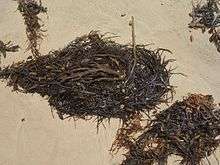Phyllospora comosa
Phyllospora comosa, known as crayweed,[1] is a species of brown algae in the Seirococcaceae family that is a type of temperate seaweed forest important as habitat for many marine species and also for producing oxygen and capturing atmospheric carbon. It is found in the oceans around Australia and New Zealand.[2] Crayweed grows up to 2.5 m in length and forms dense, shallow forests. It is abundant in cooler waters along the south-eastern coastline of Australia, around Tasmania and in South Australia and occurs to a depth of around five metres on the east coast and farther south to about three metres. On some Tasmanian coasts it can occur depths of at 18 metres. It used to occur around Sydney but has disappeared from metropolitan areas under pressure from human activities during the 1970s and 1980s.[3]
| Phyllospora comosa | |
|---|---|
.jpg) | |
| Scientific classification | |
| Kingdom: | Chromista |
| Phylum: | Ochrophyta |
| Class: | Phaeophyceae |
| Order: | Fucales |
| Family: | Seirococcaceae |
| Genus: | Phyllospora |
| Species: | P. comosa |
| Binomial name | |
| Phyllospora comosa (Labillardière) C.Agardh, 1839 | |

The algae have a central main axis, usually up to 3 m long, which bear many branches along their length, with closely arranged, leaf-like laterals. Some laterals have conceptacles, in which develop cells which produce sperm and eggs. The strongly seasonal growth of the algae depends on the length of daylight; it occurs from apical cells and is restricted to the top 20–30 cm of the branches.
Conservation efforts in Sydney
A conservation effort known as "The Crayweed Project" or "Operation Crayweed" is working to re-establish the species in the waters around Sydney.[3] Transplants have been established at sites including Malabar, Coogee, Little Bay, Freshwater and Bondi; other transplants are planned for Newport and Dee Why.[4]
References
- Gannon, Megan (17 January 2014). "Sydney's Bald Reef Gets a Seaweed Transplant". LiveScience. Archived from the original on 18 January 2014. Retrieved 19 January 2014. Alt URL
- M.D. Guiry in Guiry, M.D. & Guiry, G.M. "Phyllospora comosa (Labillardière) C.Agardh". AlgaeBase. National University of Ireland, Galway. Retrieved 9 January 2013.CS1 maint: multiple names: authors list (link)
- "The Crayweed Project". Operation Crayweed.
- Mitchell, Georgina (19 January 2020). "The conservation effort returning lost seaweed to Sydney's shores". The Sydney Morning Herald.
Further reading
- Coleman, Melinda A.; Kelaher, Brendan P. (April 17, 2009). "Connectivity among fragmented populations of a habitat-forming alga, Phyllospora comosa (Phaeophyceae, Fucales) on an urbanised coast". Marine Ecology Progress Series. 381: 63–70. Bibcode:2009MEPS..381...63C. doi:10.3354/meps07977.
- Marzinelli, E.M; Campbell, A.H; Verges, A. (April 2014). "Restoring seaweeds: does the declining fucoid Phyllospora comosa support different biodiversity than other habitats?". Journal of Applied Phycology. 26 (2): 1090. doi:10.1007/s10811-013-0158-5. S2CID 18989411.
- Shepherd, Scoresby, Graham Edgar (eds), and CSIRO., (2013) Issuing Body. Ecology of Australian Temperate Reefs: The Unique South Collingwood, Victoria, CSIRO. ISBN 9781486300099